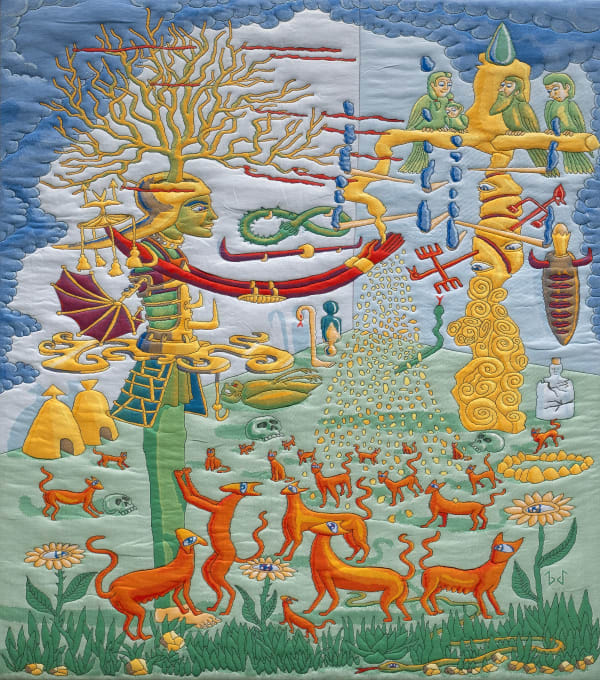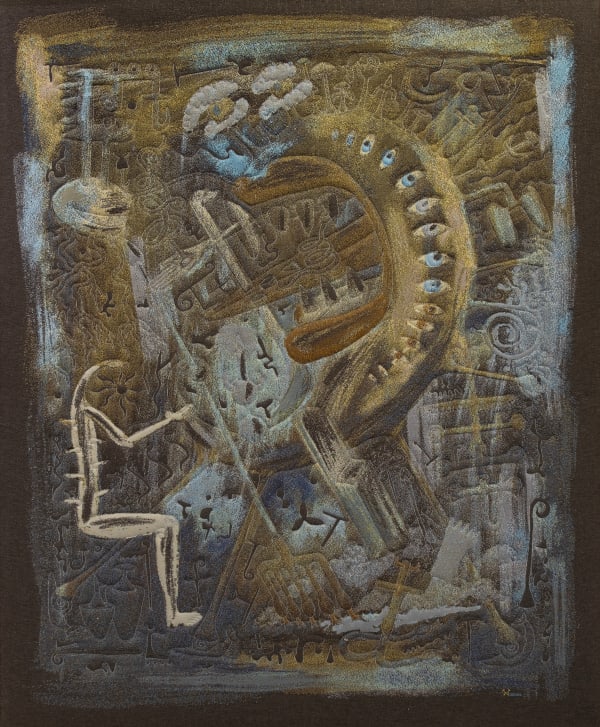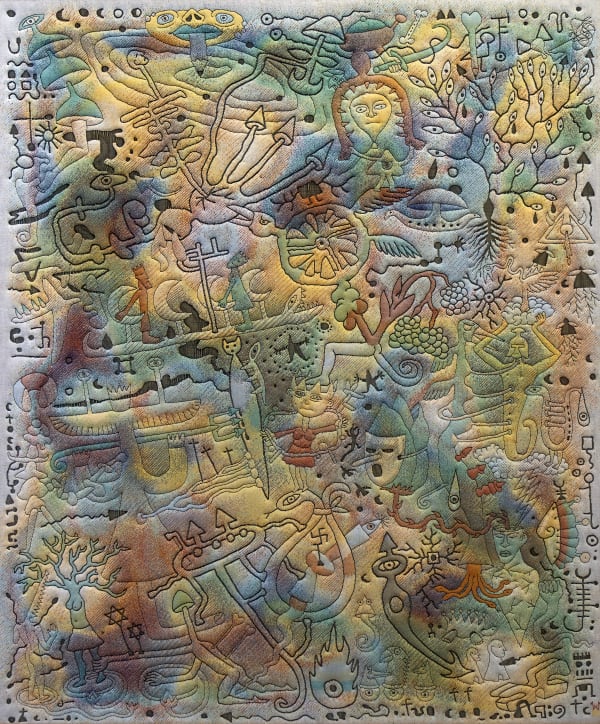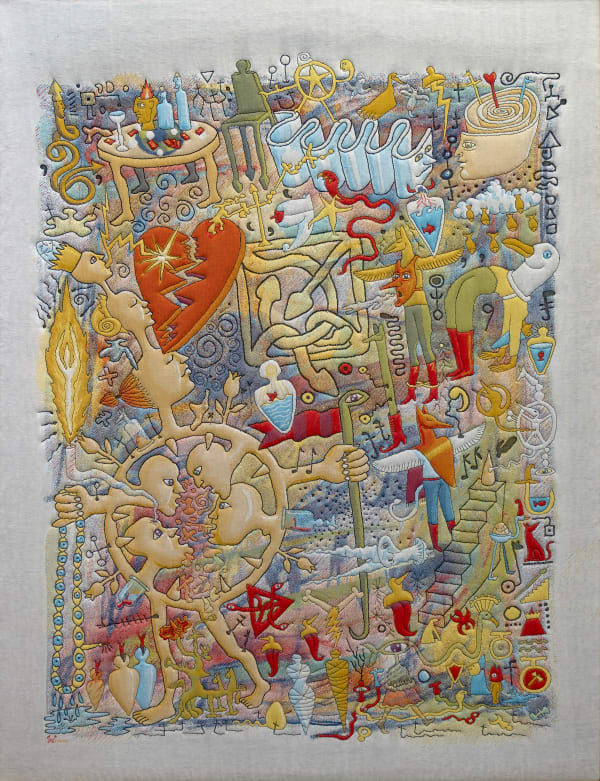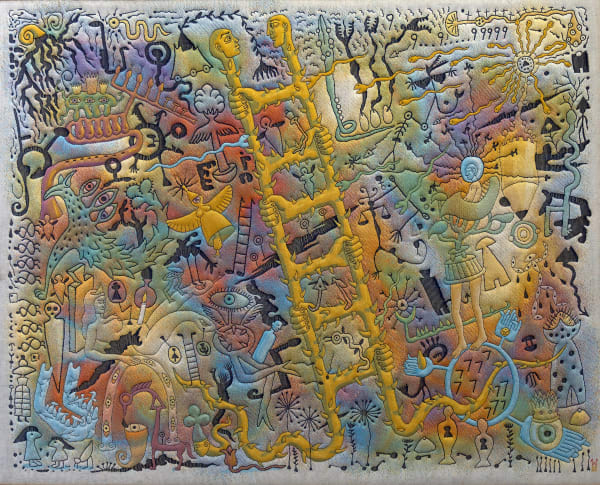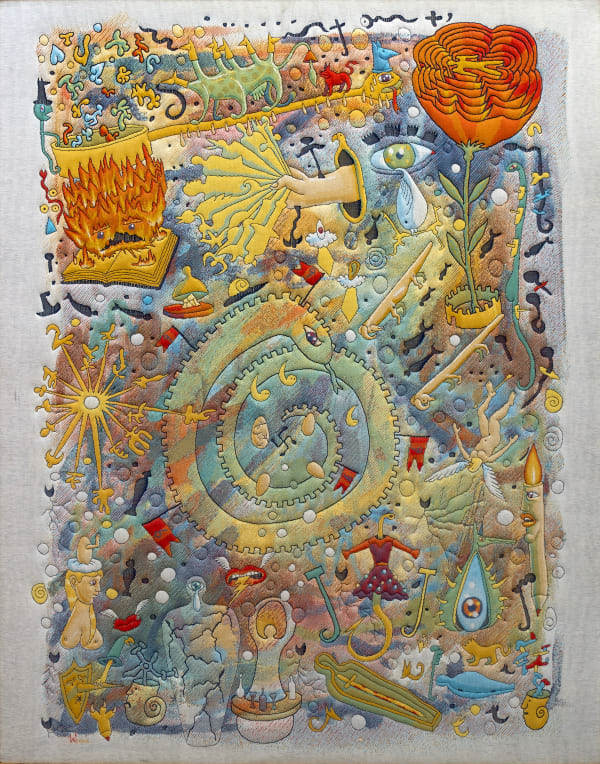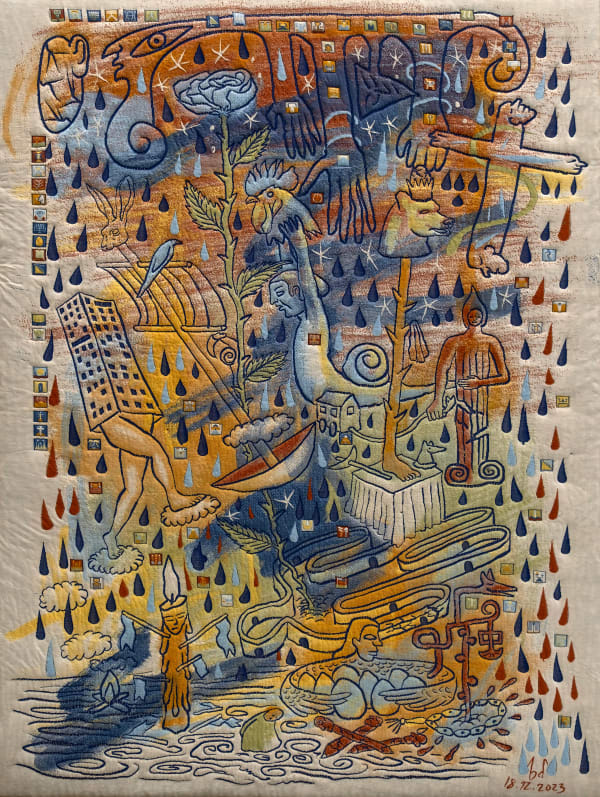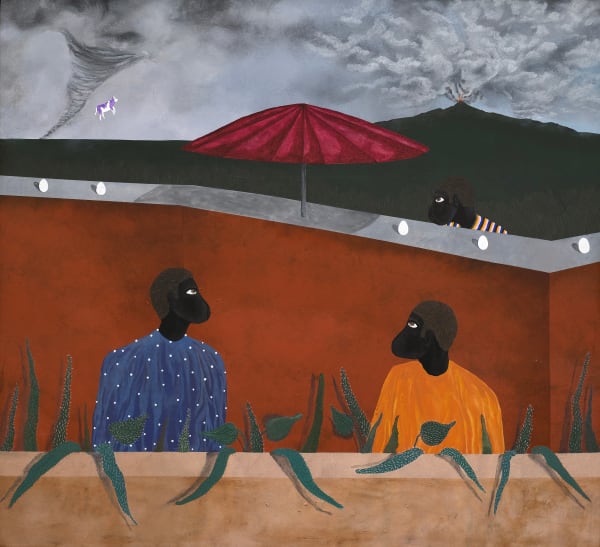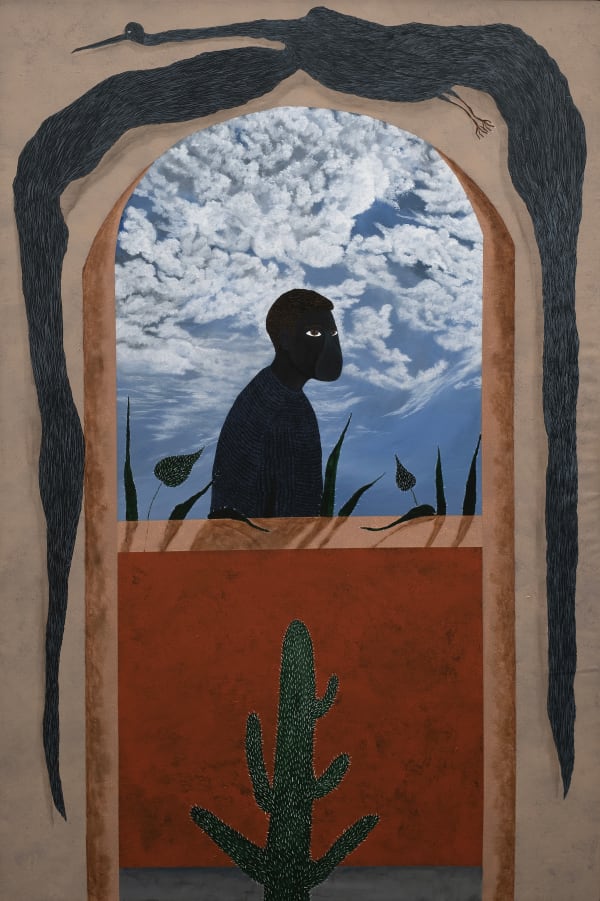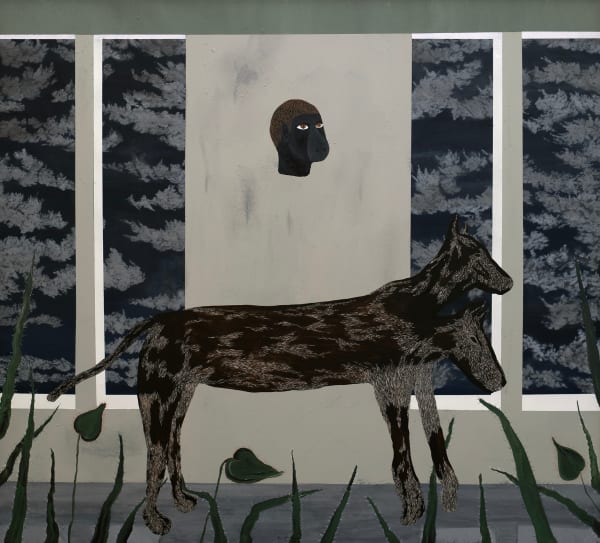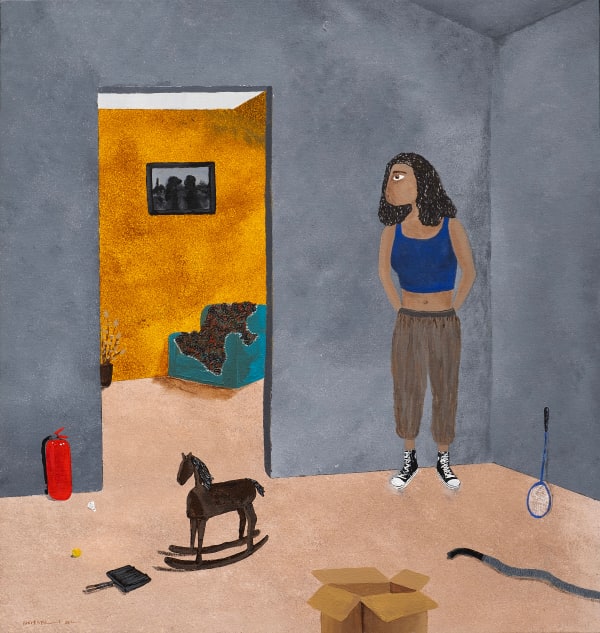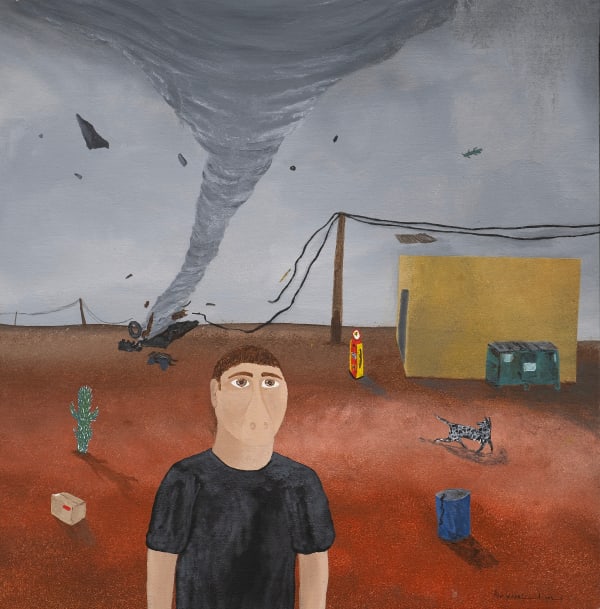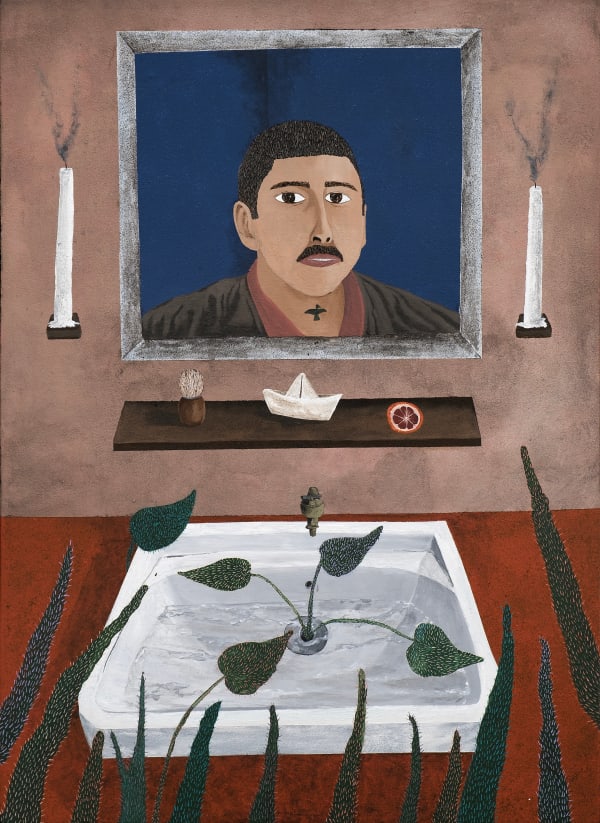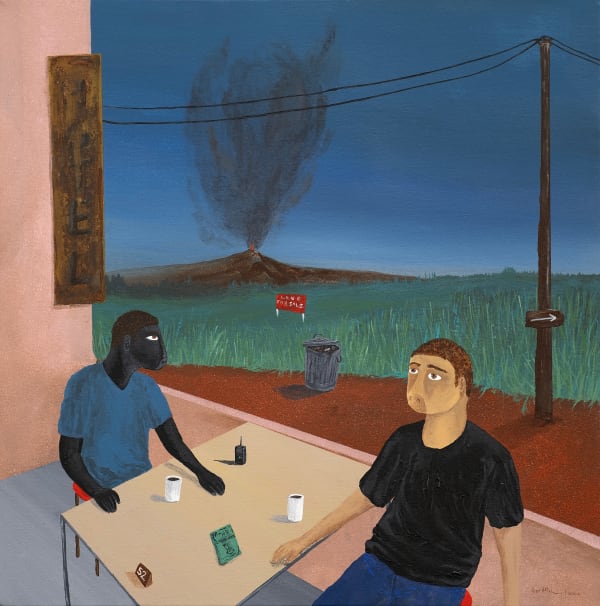Bir Günün Hikâyesi, Bir Ömrün Hakikati: Bayram Demir & İlker Kayalı
Geçmiş exhibition
Genel bakış
Every narrative begins with a void: an unspoken sentence, an unremembered moment, a feeling left unfinished… The works of İlker Kayalı and Bayram Demir revolve around these absences, each building a unique yet resonant visual language. While one turns inward, to the personal and the fragile, the other reaches outward, toward a timeless and layered truth. Yet both invite the viewer to complete the sentence, as a storyteller might.
Bayram Demir’s canvases are like temples of symbols—archetypes, figures, and universal imagery. In his works, the personal emerges through layers of collective consciousness, historical burdens, and mythological narratives. Reality is filtered through a metaphysical lens; time becomes cyclical, space symbolic. Each painting is like a ritual: wordless, yet intense. The artist reimagines age-old stories—woven into tapestries, tears turned to pearls, rituals hidden in grains of wheat.
İlker Kayalı, in contrast, draws the story from the labyrinth of the mind. His paintings visualize the silent yet striking moments of a person’s inner world. Infused with memory, emotion, and the marks of the past, these narratives are constructed through masks, silhouettes, and domestic interiors. Kayalı’s canvas is like a diary page—though not in a linear form, but more like scattered fragments from a cluttered drawer. Each painting is “a day’s story”: momentary, honest, incomplete, and real.
When Demir’s symbol-rich universe meets Kayalı’s silent monologues, painting transforms from a mere visual surface into a narrative space. These two distinct voices are in fact contemporary expressions of a shared tradition: storytelling. One speaks through myth, the other whispers through introspection. One is fable-like, the other autobiographical. Yet both construct each painting like a sentence—with a beginning, but no definitive end.
Some stories begin not with words, but with silence. The narratives in Bayram Demir’s works are born of such silence. But this silence is not a void, it is filled with meaning, intuition, and inner resonance. Every character, every work, every moment is a stage in a transformation, like chapters of a fable. But this tale does not follow a linear timeline; beginning and end meet at the same point: within the self.
Born in Kastamonu in 1981, Bayram Demir graduated from Marmara University’s Faculty of Fine Arts, Department of Painting in 2010. Having started his education in furniture and textile design, he has long worked as a design director in the textile industry. His artistic production is enriched by a deep interest in poetry, philosophy, psychology, and symbology.
Demir’s “fabric paintings” merge digital design, textile technology, and graphic art with the symbolic narratives of art history. The scenes he constructs on knitted fabric are woven with mythology, archetypes, and metaphysical concepts. This method, which pushes the limits of technique, also gives rise to an intuitive world, translating stories from the unconscious into visual language. His paintings are not merely to be seen; they are to be felt and remembered.
The symbols Demir uses like threads, grains of wheat, pearls, and gold, are not just visual motifs. They are narrative elements: silent words that carry stories. The threads represent the knots we try to untie within ourselves, and sometimes the resolution itself. The pearl symbolizes light in darkness; wheat, the wisdom that sprouts through burial in the soil. Gold represents the inner essence reached at the end of this journey: purified, pure, and true.
Taken as a whole, Demir’s works offer a visual manifestation of an archetypal story: a being is born into silence. Though this silence may initially seem like absence, it holds deep potential. Then comes a calling: paths of thread, undefined maps, familiar yet forgotten symbols… The hero—that is, each viewer, may heed the call and begin an inner journey. Thus emerges a universal tale of personal transformation.
This narrative builds a bridge between the meditative repetitions of Eastern rituals and the symbol-laden subconscious tales of the West. Like a visual rite, each artwork is a doorway, each detail a key. This ritual turns the viewer from a passive onlooker into part of the story. The images they encounter are echoes of their own inner voice.
Through art, Bayram Demir reminds modern humans of something forgotten: stories are not only told, they are lived. And some are never spoken, they are only felt. This is precisely that kind of story: not entirely personal, nor wholly collective. A story that passes through silence, nourished by transformation, and written in thread.
Born in Ordu in 1997, İlker Kayalı was drawn to art from an early age. Alongside his fine arts education, he also pursued sports as a licensed boxer, and adopted a creative process that is closely tied to poetry, music, and literature. Since 2016, he has been working in his studio in Istanbul, often constructing his paintings with a poetic sensibility.
In Kayalı’s works, personal memories, daily scenes, and emotional ruptures intertwine. Masks, faces, rooms, and symbols become carriers of both past and possibility within his figurative storytelling. Cacti and thorny plants morph into emotional wounds; vivid colors visually express emotional intensity. In every painting, the artist searches for ways to transform a single lived day into a universal lifetime.
Every person lives with a room inside their mind. Some never open a window; others don’t even remember the door. Kayalı’s paintings map these interior spaces: dim, narrow, fragile rooms… Sometimes the muffled silence of an attic, sometimes the echo of a forgotten conversation, sometimes a feeling lingering in an old childhood object. These works form a visual archive of forgotten memories, unsaid sentences, and postponed emotions.
This narrative, flowing from inside to outside, cannot be confined to a single body. At times, masked or shadowy silhouettes appear: the face of a feeling, the costume of a thought, or simply a silent gaze. Woven with Jungian intuitions, these figures act like “personas,” representing states more than individuals. But in time, the masks fall; the story begins to pulse with a personal rhythm. And in that moment, the viewer starts to hear the echo of their own footsteps in another’s mind.
Kayalı bends and folds time. Each work captures a moment in its rawest emotional state. Often painted in a single day, without pause or hesitation, because he knows that the same feeling may never return. His paintings are like inner monologues, one feels as if the artist is speaking to himself, and we’ve happened to overhear it. Sometimes a complaint, sometimes a comfort, sometimes a farewell.
Wandering among his canvases feels like flipping through the random pages of a diary. But this is not a neatly kept journal, it’s a spill of notes from mental drawers, crumpled paper, words seeping from memory boxes. “My Mind Is Elsewhere,” “Room Within a Room,” “After the Photograph”—these are not just titles; they are shadows left behind by feelings.
Houses, tables, chairs, meals, dogs, books… These are not mere backdrops, they are companions to memory and emotion. And in these visual associations, the viewer may find their own unfinished sentence. Perhaps a door that was never closed, a table that was never sat at, or a question that was never asked.
Though this story appears deeply personal, we meet it in a shared silence. Because all of us, at some point, have been caught in an “unspoken conversation.” We have all spoken while elsewhere, loved a face we could not fully see. Kayalı’s works do not resolve these moments. They simply hold them. And they leave us with a question:
Where did your story begin? And are you still there?
Eserler
-
 Bayram Demir, Altın Buğdaylar / Golden Wheats, 2023
Bayram Demir, Altın Buğdaylar / Golden Wheats, 2023 -
 Bayram Demir, Yavaş Akış / Slow Flow, 2024
Bayram Demir, Yavaş Akış / Slow Flow, 2024 -
 Bayram Demir, Sessiz Bağlantılar / Silent Connections, 2024
Bayram Demir, Sessiz Bağlantılar / Silent Connections, 2024 -
 Bayram Demir, Sessiz Doğumlar / Silent Births, 2024
Bayram Demir, Sessiz Doğumlar / Silent Births, 2024
-
 Bayram Demir, Zikir / Dhikr, 2024
Bayram Demir, Zikir / Dhikr, 2024 -
 Bayram Demir, Bende Bu Var / This is What I Have, 2024
Bayram Demir, Bende Bu Var / This is What I Have, 2024 -
 Bayram Demir, Zıtlıkların Anlamı / The Meaning of Opposites, 2024
Bayram Demir, Zıtlıkların Anlamı / The Meaning of Opposites, 2024 -
 Bayram Demir, Dirilen Ateş / Resurrected Fire, 2024
Bayram Demir, Dirilen Ateş / Resurrected Fire, 2024
-
 Bayram Demir, Damlalar V1 / Drops V1, 2023
Bayram Demir, Damlalar V1 / Drops V1, 2023 -
 İlker Kayalı, Duvarın Ardında / Behind the Wall, 2025
İlker Kayalı, Duvarın Ardında / Behind the Wall, 2025 -
 İlker Kayalı, Dalgın Kanatların Ardında / Behind Absentminded Wings, 2025
İlker Kayalı, Dalgın Kanatların Ardında / Behind Absentminded Wings, 2025 -
 İlker Kayalı, Ölümden Daha Sessiz / Quieter Than Death, 2025
İlker Kayalı, Ölümden Daha Sessiz / Quieter Than Death, 2025
Sergi Görünümü

